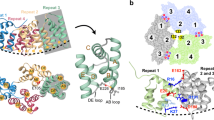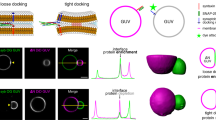Abstract
THE transmembrane domain of the α chain of the T-cell receptor is responsible both for its assembly with the CD3 δ chain1 and for rapid degradation of the unassembled chain within the endoplasmic reticulum2,3. The determinant for both assembly and degradation is located in a segment of eight residues containing two basic amino acids (Fig. 1). We show here that placement of a single basic residue in the transmembrane domain of the Tac antigen can induce interaction with the CD3 chain, through its transmembrane acidic residue. This interaction is most favoured when the interacting residues are located at the same level in the membrane. The ability to induce protein–protein interaction by placing charge pairs within transmembrane domains suggests an approach to producing artificial dimers.
This is a preview of subscription content, access via your institution
Access options
Subscribe to this journal
Receive 51 print issues and online access
$199.00 per year
only $3.90 per issue
Buy this article
- Purchase on Springer Link
- Instant access to full article PDF
Prices may be subject to local taxes which are calculated during checkout
Similar content being viewed by others
References
Manolios, N., Bonifacino, J. S. & Klausner, R. D. Science 249, 274–277 (1990).
Bonifacino, J. S., Suzuki, C. K. & Klausner, R. D. Science 247, 79–82 (1990).
Bonifacino, J. S., Cosson, P. & Klausner, R. D. Cell 63, 503–513 (1990).
Leonard, W. J. et al. Nature 311, 626–631 (1984).
Raulet, D. H. A. Rev. Immun. 7, 175–207 (1989).
Engelman, D. M., Steitz, T. A. & Goldman, A. A. Rev. Biophys. biophys. Chem. 15, 321–353 (1986).
Parsegian, A. Nature 221, 844–846 (1969).
Honig, B. G. & Hubbell, W. L. Proc. natn. Acad. Sci. U.S.A. 81, 5412–5416 (1984).
Wienands, J., Hombach, J., Radbruch, A., Riesterer, C. & Reth, M. EMB0 J. 9, 449–455 (1990).
Kinet, J.-P. Cell 57, 351–354 (1989).
van den Elsen, P., Shepley, B. A., Cho, M. & Terhorst, C. Nature 314, 542–544 (1985).
Kyte, J. & Doolittle, R. F. J. molec. Biol. 157, 105–132 (1982).
Higuchi, R., Krummel, B. & Saiki, R. K. Nucleic Acid Res. 16, 7351–7367 (1988).
Samelson, L. E., Harford, J. B. & Klausner, R. D. Cell 43, 223–231 (1985).
Samelson, L. E., Weissman, A. M., Robey, F. A., Berkowen, I. & Klausner, R. D. J. Immun. 137, 3254–3258 (1986).
Rubin, L. A., Kurman, C. C., Biddison, W. E., Goldman, N. D. & Nelson, D. L. Hybridoma 4, 91–102 (1985).
Author information
Authors and Affiliations
Rights and permissions
About this article
Cite this article
Cosson, P., Lankford, S., Bonifacino, J. et al. Membrane protein association by potential intrarnembrane charge pairs. Nature 351, 414–416 (1991). https://doi.org/10.1038/351414a0
Received:
Accepted:
Issue Date:
DOI: https://doi.org/10.1038/351414a0
This article is cited by
-
The genomic organization and expression pattern of the low-affinity Fc gamma receptors (FcγR) in the Göttingen minipig
Immunogenetics (2019)
-
Role of the HIV-1 envelope transmembrane domain in intracellular sorting
BMC Cell Biology (2018)
-
Stoichiometry and intracellular fate of TRIM-containing TCR complexes
Cell Communication and Signaling (2010)
-
The membrane-spanning domain of gp41 plays a critical role in intracellular trafficking of the HIV envelope protein
Retrovirology (2010)
-
Membrane topology analysis of HIV-1 envelope glycoprotein gp41
Retrovirology (2010)
Comments
By submitting a comment you agree to abide by our Terms and Community Guidelines. If you find something abusive or that does not comply with our terms or guidelines please flag it as inappropriate.



